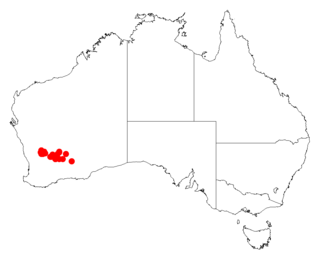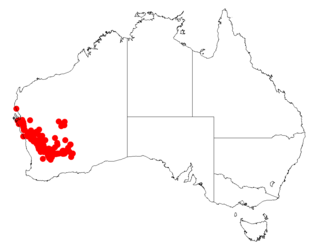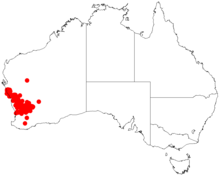
Acacia kempeana, commonly known as wanderrie wattle, witchetty bush or granite wattle, is a shrub in subfamily Mimosoideae of family Fabaceae that is endemic to arid parts of central and western Australia.

Acacia cerastes is a shrub belonging to the genus Acacia. It is native to a small area in the northern Wheatbelt region of Western Australia.

Acacia daviesioides is a shrub belonging to the genus Acacia. It is native to Western Australia. The species was first described by the botanist C.A.Gardner in the Journal of the Royal Society of Western Australia in 1942.

Acacia incurva is a shrub belonging to the genus Acacia. It is native to the South West region of Western Australia.

Acacia pterocaulon is a shrub belonging to the genus Acacia and subgenus Alatae. It is native to a small area in the Mid West region of Western Australia.

Acacia chrysochaeta is a shrub belonging to the genus Acacia and the subgenus Juliflorae that is endemic to a small area of north western Australia.

Acacia cylindrica is a shrub belonging to the genus Acacia and the subgenus Juliflorae that is endemic to western Australia.

Acacia dacrydioides is a shrub belonging to the genus Acacia and the subgenus Juliflorae that is endemic to north western Australia.

Acacia gardneri is a shrub belonging to the genus Acacia and the subgenus Juliflorae native to Western Australia.

Acacia gibbosa is a shrub or tree belonging to the genus Acacia and the subgenus Juliflorae native to Western Australia.

Acacia gonocarpa, commonly known as wuluru, is a tree or shrub belonging to the genus Acacia and the subgenus Juliflorae. It is native to northern Australia.

Acacia paraneura, commonly known as weeping mulga, is a tree or shrub belonging to the genus Acacia and the subgenus Juliflorae. It is native to arid regions of Australia. The Indigenous Kurrama peoples know the tree as warlun.

Acacia stipuligera is a tree or shrub belonging to the genus Acacia and the subgenus Juliflorae. It is native to arid and tropical parts of northern Australia.
Acacia synoria is a tree or shrub, also known as goodlands wattle, belonging to the genus Acacia and the subgenus Juliflorae that is endemic to a small area of western Australia.

Acacia tenuissima, commonly known as narrow-leaved wattle, broom wattle, minyana, slender mulga or slender wattle, is a shrub belonging to the genus Acacia and the subgenus Juliflorae endemic to temperate and tropical areas of Australia. Indigenous Australians the Kurrama peoples know the plant as Janangungu and the Banyjima know it as Murruthurru.

Acacia hastulata is a shrub belonging to the genus Acacia and the subgenus Phyllodineae that is endemic to an area in south western Australia.

Acacia scirpifolia is a shrub or tree of the genus Acacia and the subgenus Phyllodineae that is endemic to western Australia

Acacia donaldsonii is a shrub of the genus Acacia and the subgenus Plurinerves that is endemism in an area of south western Australia.

Acacia longispinea is a shrub or tree of the genus Acacia and the subgenus Plurinerves that is endemic to an area of south western Australia.

Acacia semilunata is a shrub or tree belonging to the genus Acacia and the subgenus Phyllodineae native to north eastern Australia.




















